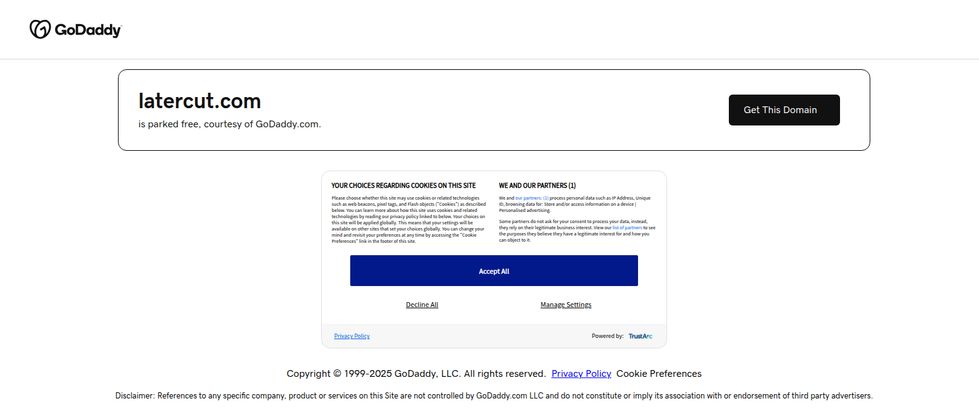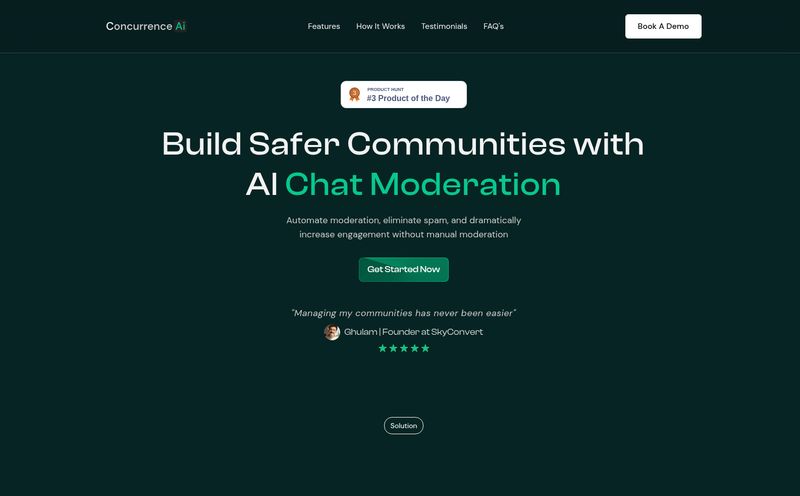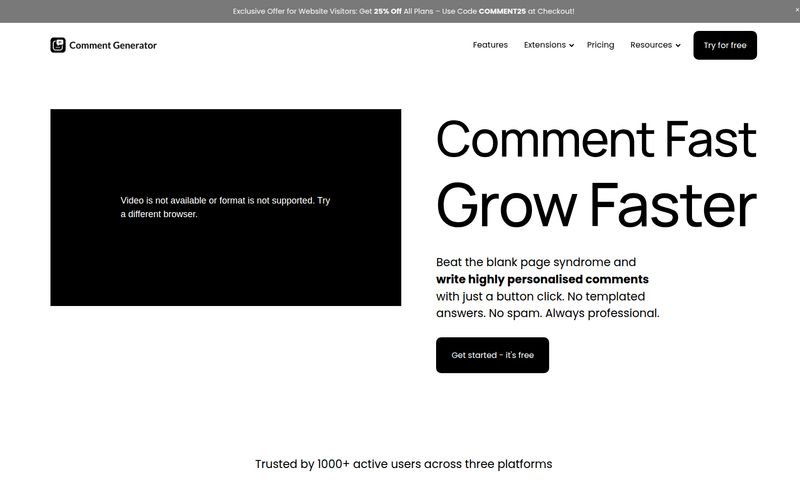As someone who lives and breathes SEO and content, I’m always on the hunt for the next big thing. The tool that’s going to save us all from the endless content treadmill. A few weeks ago, I caught wind of a name that was buzzing in some niche marketing circles: Latercut. The promise was electrifying: create short-form social videos 10 times faster with the power of AI.
My interest was piqued. I mean, who doesn't want to reclaim hours of their life from the clutches of video editing software? I pictured a world with less timeline scrubbing and more… well, anything else. So, I navigated over to their website, ready to be wowed, ready to sign up for a beta.
And I found… a GoDaddy parking page. Yep. The digital equivalent of a vacant lot with a “Coming Soon” sign that’s been collecting dust for a year. It’s like finding a treasure map where ‘X’ marks the spot, but the island seems to have sunk. A real head-scratcher.
But the idea was too good to just let go. So I put on my digital deerstalker hat and did some digging. What exactly was Latercut supposed to be, and is it a sign of where the industry is heading, even if the tool itself is currently MIA?
What Was the Big Promise of Latercut?
At its core, Latercut was designed to be a creator’s best friend for the short-form video boom. Think TikTok, Instagram Reels, and YouTube Shorts. The main selling point, plastered everywhere I found a mention of it, was that it could help you “ship shorts 10x faster.” As a professional who has spent way too many late nights tweaking 15-second clips, that claim is basically a siren song.

Visit Latercut
The concept wasn't just about speed, but about simplification. It was supposed to use AI to handle the tedious parts of video creation: data input, retouching, and even publishing. It was aiming to be the one-stop-shop for anyone who knew they needed to be doing short-form video but just couldn’t stomach the workflow.
The Killer Features We Were All Waiting For
This is where it gets really interesting. It wasn’t just a generic “AI video editor.” The feature set was specific, targeted, and honestly, pretty smart. It showed a deep understanding of what modern creators actually struggle with.
The Rise of the Faceless Creator
One of the most hyped features was faceless video creation. This is HUGE. The trend of “faceless” YouTube and TikTok channels is exploding. These are channels that use stock footage, animations, screen recordings, and voiceovers to create compelling content without ever showing the creator's face. It's a massive win for introverts or people who just want to keep their privacy. A tool that streamlines this process? That’s not just a feature; it's a business model for thousands of aspiring creators.
From Podcasts to Viral Clips in a Snap
Another brilliant idea was the podcast shortener. If you're a podcaster, you know the pain. You record an hour of amazing audio, but getting that content onto video-first platforms like TikTok or Reels is a chore. You have to find the best clips, add captions, find some engaging background video… it’s a whole new job. Latercut promised to automate this, turning audio gold into social media gold. This is something tools like Opus Clip have run with, and for good reason.
More Than Just Cuts and Captions
The list of promised features went on, painting a picture of a really versatile platform. It included things like a Quiz Engager to make interactive videos, a Video Reaction template (a staple of YouTube culture), and even a Gaming Storytelling mode. These aren’t just tools; they're templates for proven, high-engagement content formats. It felt like they’d taken a look at what was going viral and decided to build a shortcut to get there. Smart.
The Potential Highs and Predictable Lows
No tool is perfect, of course. Based on the info I could piece together, and my experience with similar platforms, I can already guess what the pros and cons would have been. On the plus side, the sheer speed and the AI-powered simplification would have been game-changers. The direct integration with social platforms is another huge timesaver.
However, I could see a few bumps in the road. There's almost always a learning curve with AI tools to get them to really do what you want. And then there's the template trap. While templates are great for speed, they can sometimes lead to a sea of same-y looking content if you're not careful. The real pros know how to use templates as a starting point, not a destination. And the biggest question mark for me was the “free” tier. So many AI tools offer a free trial that's so limited it's barely usable. It was unclear how generous Latercut was planning to be.
So, What Happened to Latercut? And What's the Price?
This is the million-dollar question, isn't it? A promising tool with a well-defined feature set, and then… poof. The domain is parked. In the fast-moving world of tech startups, this could mean anything:
- They ran out of funding before they could launch. The most common and unfortunate story.
- They're in the middle of a pivot or a rebrand and will emerge under a new name.
- It was a solo dev’s passion project that got put on the back burner.
- They were acquired by a larger company before they even launched (we call this an 'acquihire').
We might never know. As for the pricing, your guess is as good as mine. There was no pricing page to be found. I'd speculate it would have been a SaaS model, probably with tiered subscriptions ranging from $15 to $50 a month, depending on the number of exports and access to premium features. That seems to be the sweet spot in this market.
Great Alternatives You Can Actually Use Today
While we mourn the ghost of Latercut, the good news is that the idea behind it is alive and well. If you're looking for tools that do similar things, you’re in luck. Here are a few solid alternatives I've personally used:
- Veed.io: A fantastic and mature online video editor. It has a ton of features, from auto-captioning to templates and screen recording. It’s a bit more hands-on than what Latercut promised, but it's incredibly powerful.
- Descript: This one is a titan, especially for anyone working with podcasts or voiceovers. It edits video like a text document. Its 'Studio Sound' feature is pure magic, and it's great for pulling out short clips from longer content.
- Opus Clip: As mentioned earlier, this tool is laser-focused on turning long-form videos (like podcasts or speeches) into multiple, viral-ready short clips with AI. It's probably the closest thing to Latercut's promised 'podcast shortener'.
Final Thoughts on a Promising Ghost
So, we're left with the tale of Latercut, a tool that was either a brilliant idea that never saw the light of day or a clever bit of pre-launch marketing that's still… pre-launching. Who knows, maybe tomorrow the site will be live and we’ll all be creating shorts 10x faster. I genuinely hope so.
But even if it never materializes, its ghost serves as a great blueprint for what creators need right now: smarter, faster, and more intuitive ways to conquer the content beast. The demand is there. Now we just need the tools to catch up. For now, I'll keep my eye on that vacant GoDaddy lot, just in case.
Frequently Asked Questions
What was Latercut supposed to be?
Latercut was marketed as an AI-powered platform designed to help content creators make short-form videos for platforms like TikTok, YouTube Shorts, and Instagram Reels much faster—claiming a 10x speed increase by simplifying editing, retouching, and publishing.
Is the Latercut tool available to use?
As of this writing, no. The official domain for Latercut, latercut.com, is currently a parked page on GoDaddy, suggesting the tool is not publicly available or may no longer be in development.
What were the key features of Latercut?
Latercut's standout features included AI-powered video creation, a dedicated mode for creating faceless videos, a podcast shortener to turn audio into video clips, quiz engagers, and templates for reaction videos and gaming content.
Why is faceless video creation a significant feature?
Faceless content is a rapidly growing trend on social media, allowing creators to produce videos using stock footage, B-roll, and voiceovers without showing their face. A tool that automates this process lowers the barrier to entry for many people who value privacy or are camera-shy.
Are there any good alternatives to Latercut?
Yes, absolutely. While Latercut itself may be unavailable, several excellent tools offer similar functionality. Some of the best alternatives include Veed.io for general online video editing, Descript for its unique text-based video editing, and Opus Clip for its AI-powered long-form to short-form video clipping.
Was there any pricing information for Latercut?
No pricing information was ever officially released. Given the market for similar AI video tools, it likely would have been a monthly subscription model, but this is purely speculation.
Reference and Sources
- Veed.io: https://www.veed.io/
- Descript: https://www.descript.com/
- Opus Clip: https://www.opus.pro/



